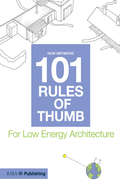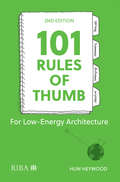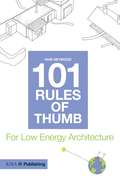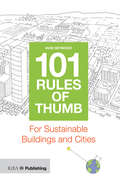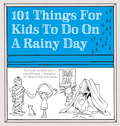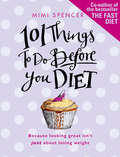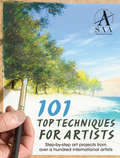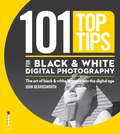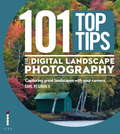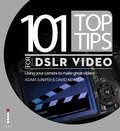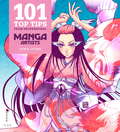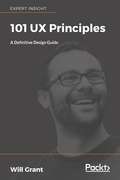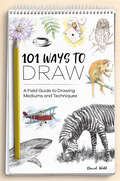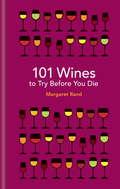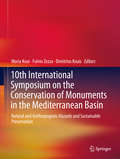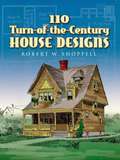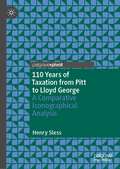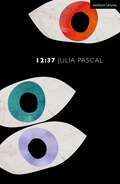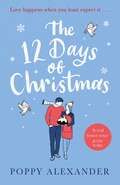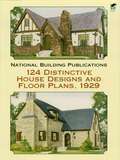- Table View
- List View
101 Rules of Thumb for Low Energy Architecture
by Huw Heywood101 Rules of Thumb sets out the essential elements of low energy architecture in a fresh, intuitive way. In an area where ever-changing technology and complex legislation and can cloud the designer’s thought-processes, this book encourages the designer to think clearly and intuitively about the fundamentals of low energy buildings. With reliable, simple rules of thumb that will provide new ideas and refresh the designer’s palette, each page focuses on a single piece of advice or guidance along with a clear hand-drawn illustration, while there are also plenty of tips and more detailed information for those who wish to dig deeper. The emphasis is on passive low-energy principles, and the rules of thumb cover all the design fundamentals from site and location to orientation and form, peppered with some which will help the designer to think ‘outside the box’ about the design process itself.
101 Rules of Thumb for Low Energy Architecture
by Huw Heywood101 Rules of Thumb sets out the essential elements of low energy architecture in a fresh, intuitive way. In an area where ever-changing technology and complex legislation and can cloud the designer’s thought-processes, this book encourages the designer to think clearly and intuitively about the fundamentals of low energy buildings. With reliable, simple rules of thumb that will provide new ideas and refresh the designer’s palette, each page focuses on a single piece of advice or guidance along with a clear hand-drawn illustration, while there are also plenty of tips and more detailed information for those who wish to dig deeper. The emphasis is on passive low-energy principles, and the rules of thumb cover all the design fundamentals from site and location to orientation and form, peppered with some which will help the designer to think ‘outside the box’ about the design process itself.
101 Rules of Thumb for Low-Energy Architecture
by Huw HeywoodBuildings and construction are a major contributor to the climate and biodiversity emergency. They account for nearly 40% of energy-related carbon dioxide (CO2) emissions. It is more important than ever for architects to design responsibly and create low-carbon, low-energy buildings for a sustainable future. 101 Rules of Thumb sets out the essential elements of low-energy architecture in a fresh, intuitive way. Where ever-changing technology and complex legislation can cloud the designer’s thought-process, this book equips you with the fundamentals you need to minimise CO2 emissions, design for low-energy use and work with, not against, the forces of nature. With reliable, simple rules of thumb, each page focuses on a single piece of guidance along with a clear hand-drawn illustration. The emphasis is on passive low-energy principles, and the rules of thumb cover all the design fundamentals from site and location to orientation and form, peppered with ideas to help the designer think outside the box, drawing inspiration from traditional methods, photoperiodic plants, and the black-tailed prairie dog. An extended, fully updated narrative bibliography explores the sources in detail and provides a valuable springboard for further study. Applicable throughout the world in any climate region, 101 Rules of Thumb is a global primer to be dipped into at any time as a quick means of re-focusing on what’s important when designing a new or retrofitted low-energy building. The rules cover: Site and location Orientation and form The low-energy building envelope Carbon free heating, cooling and lighting Passive low-energy principles.
101 Rules of Thumb for Low-Energy Architecture
by Huw HeywoodBuildings and construction are a major contributor to the climate and biodiversity emergency. They account for nearly 40% of energy-related carbon dioxide (CO2) emissions. It is more important than ever for architects to design responsibly and create low-carbon, low-energy buildings for a sustainable future. 101 Rules of Thumb sets out the essential elements of low-energy architecture in a fresh, intuitive way. Where ever-changing technology and complex legislation can cloud the designer’s thought-process, this book equips you with the fundamentals you need to minimise CO2 emissions, design for low-energy use and work with, not against, the forces of nature. With reliable, simple rules of thumb, each page focuses on a single piece of guidance along with a clear hand-drawn illustration. The emphasis is on passive low-energy principles, and the rules of thumb cover all the design fundamentals from site and location to orientation and form, peppered with ideas to help the designer think outside the box, drawing inspiration from traditional methods, photoperiodic plants, and the black-tailed prairie dog. An extended, fully updated narrative bibliography explores the sources in detail and provides a valuable springboard for further study. Applicable throughout the world in any climate region, 101 Rules of Thumb is a global primer to be dipped into at any time as a quick means of re-focusing on what’s important when designing a new or retrofitted low-energy building. The rules cover: Site and location Orientation and form The low-energy building envelope Carbon free heating, cooling and lighting Passive low-energy principles.
101 Rules of Thumb for Low Energy Architecture (PDF)
by Huw Heywood101 Rules of Thumb sets out the essential elements of low energy architecture in a fresh, intuitive way. In an area where ever-changing technology and complex legislation and can cloud the designer’s thought-processes, this book encourages the designer to think clearly and intuitively about the fundamentals of low energy buildings. With reliable, simple rules of thumb that will provide new ideas and refresh the designer’s palette, each page focuses on a single piece of advice or guidance along with a clear hand-drawn illustration, while there are also plenty of tips and more detailed information for those who wish to dig deeper. The emphasis is on passive low-energy principles, and the rules of thumb cover all the design fundamentals from site and location to orientation and form, peppered with some which will help the designer to think ‘outside the box’ about the design process itself.
101 Rules of Thumb for Sustainable Buildings and Cities
by Huw HeywoodPeople across the world are becoming more aware of the need for the buildings and cities they live and work in to be sustainable, but the issue of how to be sustainable can seem a confusing and complex one. These rules of thumb provide universal guidelines for the sustainable design of both buildings and the urban realm. It’s a global primer and textbook for anyone interested in understanding sustainability in the built environment, an ideal starting point for students as well as an aide memoir for more experienced readers and practitioners interested in this field.
101 Rules of Thumb for Sustainable Buildings and Cities
by Huw HeywoodPeople across the world are becoming more aware of the need for the buildings and cities they live and work in to be sustainable, but the issue of how to be sustainable can seem a confusing and complex one. These rules of thumb provide universal guidelines for the sustainable design of both buildings and the urban realm. It’s a global primer and textbook for anyone interested in understanding sustainability in the built environment, an ideal starting point for students as well as an aide memoir for more experienced readers and practitioners interested in this field.
101 Things for Kids to do on a Rainy Day
by Dawn IsaacFrom the author of 101 Things for Kids to do Outside, which has fast become a go-to book for children and parents alike, comes this excellent new volume full of creative (and occasionally crazy) ideas for things to do when the weather is bad and you're stuck inside - without having to go any where near a TV or computer screen! Why not grow a windowsill herb garden, make your own jigsaw, or learn to play the glasses? Get crafty with decoupage and salt dough, or play detective by dusting for fingerprints. Exciting makes include terrariums and kaleidoscopes, whilst wacky games cover everything from Balloon Stomp to Sticky Note Scramble. All 101 ideas are designed to be achievable with little or no parental help, and only use materials that you already have around the house. With a wealth of creative and fun suggestions to keep you amused, you might not even notice that the rain has stopped.
101 Things to Do Before You Diet: Because Looking Great Isn't Just About Losing Weight
by Mimi SpencerFrom the co-author (with Michael Mosley) of the bestselling The Fast Diet, a feel-good, fun book that reveals the secrets that will make a difference to how you look and feel about yourself. Because looking great isn't just about losing weight!Ways to eat, ways to cheat. What to wear, what to ditch.This sassy, funny and practical book by style guru Mimi Spencer includes how to find the perfect jeans; fix your fattening habits; avoid calorie ambush; and learn to give good photo. It also reveals the secrets of solution lingerie; and why you need one diet dress. Mimi will help you make the most of what you've got, and see that the woman you are now is just as fabulous as the woman you want to be.Like your ideal best friend, she'll help you release your thinner self without all the depressing self-denial, guilty weigh-ins and tyranny of faddy food plans.
101 Top Techniques for Artists: Step-by-step art projects from over a hundred international artists
by SAA101 Top Techniques for Artists is a colourful compendium packed full of practical tips and techniques by 101 of today’s most popular leading artists. Each technique is presented in clear, simple step-by-step instructions that describe how to complete the project yourself, including a full list of materials and detailed images to guide you along the way.Divided into seven chapters that cover watercolours, acrylics, oils, pastels, drawing and mixed media, this handy book is bursting with some of the most popular styles and subjects, designed to showcase the very best of artistic abilities available to help develop your own creative streak.All contributors featured in this book are professional artists belonging to the SAA, who together with a global community of over 46,000 other members, make up the world’s largest and friendliest art society. Whether you’re a beginner, an improver or a professional, there’s something new to learn for everyone in this comprehensive collection.
101 Top Tips for Black & White Digital Photography: The Art of Black & White Brought into the Digital Age
by John BeardsworthA comprehensive look at black & white photography by one of today's leading experts on digital-editing software and black & white conversion techniques.John Beardsworth explores the most powerful software for converting your color shots into stunning, high-quality black-and-white photos, with detailed explanations of how each tool works and why to try it out on your own images. His streamlined methods will optimise your workflow and inspire your photography.In addition to providing an abundance of step-by-step instructions with brilliant imagery, Beardsworth also teaches the aesthetic value of black and white, and how to visualise the creative potential of each shot. With its fun and approachable tips-based structure, this book will motivate you to experiment with impressive effects and innovative tools, ensuring that you make full use of the B&W software at your disposal.
101 Top Tips for Digital Landscape Photography: Capturing Great Landscapes With Your Camera (101 Top Tips Series)
by Carl Heilman IIA comprehensive guide to improving your landscape photography by one of today's foremost landscape photographers.Landscape photography is perhaps the single most popular genre among DSLR owners. In 101 Top Tips for Digital Landscape Photography, experienced professional landscape guru Carl Heilman II gives the benefit of a lifetime spent shooting spectacular wilderness and mountain shots, offering a host of targeted tips and tricks that will allow photographers of all abilities to lift their landscape work to the next level.The reader will learn how to harness natural drama, use difficult lighting situations to your advantage and capture unusual perspectives, all the while benefiting from Carl's clear instruction and beautiful landscape work.
101 Top Tips for DSLR Video: Using your camera to make great videos
by Adam Juniper David NewtonFollowing the arrival of game-changing new cameras from Nikon and Canon, the hottest area in the world of photography has been combining high-definition video capability with all the advantages of SLR's interchangeable lenses. For the first time, full cinematic creativity is within anyone's grasp.With its tips-based structure, this book can be dipped into for reference for movie-makers of any background, or read cover to cover for a complete course in movie-making. With four case studies from real-world professional projects, including a TV advertisement and a music video, 101 Top Tips for DSLR Video provides invaluable guidance for any budding filmmakers.Top Tips for DSLR Video also includes four case studies from real-world professional projects, including a TV advertisement and a music video. Taking you all the way from understanding and choosing the technology, to planning, shooting, editing, and finally publishing your movie, this book contains everything you really need to know about making video with your digital SLR camera.
101 Top Tips from Professional Manga Artists
by Sonia Leong Meredith WalshAs a sophisticated and highly stylised art form, Manga presents a series of challenges for budding artists, from character and set design to creating dynamic page layouts, perfectly paced narrative and panels with ever-changing camera angles.Here, award-winning professional Manga artist Sonia Leong and a collective of acclaimed creators lay bare the expert techniques that you need, from essential drawing tips to designing characters, painting vivid illustrations and exciting storytelling.Manga comes in a variety of styles, from kawaii (cute) to hyper-realistic. 101 Top Tips from Professional Manga Artists identifies the key features of each, enabling you to develop your individual style.Including both traditional and digital art methods alongside tips on becoming a professional, 101 Top Tips from Professional Manga Artists is the ultimate resource for beginners and more experienced artists alike.
101 UX Principles: A Definitive Design Guide
by Will GrantLearn from the opinions of a UX expert, evaluate your own design principles, and avoid common mistakes. Key Features Hear insights from an author who was trained by the Nielsen Norman Group Browse over 20 years of collected UX insights Accept or reject 101 thought-provoking opinions on design Challenge your own ideas on UX Book Description There are countless books about designing for the web. They all give multiple routes and options to solving design challenges. Many of them are plain wrong. This has led to an entire generation of designers failing to make interfaces that are usable, software that is intuitive, and products that normal people can understand. 101 UX Principles changes that, with 101 ways to solve 101 UX problems clearly and single-mindedly. The 101 principles are opinionated. They'll rub some designers up the wrong way, but these principles are rooted in 20 years of building for the web. They're not based on theory - they're based on practice. Simply put, they've been proven to work at scale. There's no arguing with that. Following in the footsteps of Jakob Nielsen and Don Norman, this book is the go-to manual for UX professionals, covering everything from passwords, to planning the user journey. Build a deeper understanding of accessible design and implement tried-and-tested strategies in your company. What you will learn Use typography well to ensure that text is readable Design controls to streamline interaction Create navigation which makes content make sense Convey information with consistent iconography Manage user input effectively Represent progress to the user Provide interfaces that work for users with visual or motion impairments Understand and respond to user expectations Who this book is for This book is for UX professionals (freelance or in-house) looking for shortcuts to making software that users intuitively know how to use across web, desktop, and mobile.
101 UX Principles: A Definitive Design Guide
by Will GrantLearn from the opinions of a UX expert, evaluate your own design principles, and avoid common mistakes. Key Features Hear insights from an author who was trained by the Nielsen Norman Group Browse over 20 years of collected UX insights Accept or reject 101 thought-provoking opinions on design Challenge your own ideas on UX Book Description There are countless books about designing for the web. They all give multiple routes and options to solving design challenges. Many of them are plain wrong. This has led to an entire generation of designers failing to make interfaces that are usable, software that is intuitive, and products that normal people can understand. 101 UX Principles changes that, with 101 ways to solve 101 UX problems clearly and single-mindedly. The 101 principles are opinionated. They'll rub some designers up the wrong way, but these principles are rooted in 20 years of building for the web. They're not based on theory - they're based on practice. Simply put, they've been proven to work at scale. There's no arguing with that. Following in the footsteps of Jakob Nielsen and Don Norman, this book is the go-to manual for UX professionals, covering everything from passwords, to planning the user journey. Build a deeper understanding of accessible design and implement tried-and-tested strategies in your company. What you will learn Use typography well to ensure that text is readable Design controls to streamline interaction Create navigation which makes content make sense Convey information with consistent iconography Manage user input effectively Represent progress to the user Provide interfaces that work for users with visual or motion impairments Understand and respond to user expectations Who this book is for This book is for UX professionals (freelance or in-house) looking for shortcuts to making software that users intuitively know how to use across web, desktop, and mobile.
101 Ways to Draw: A Field Guide to Drawing Mediums and Techniques
by David WebbFrom soft pencils to graphite powder, ballpoint to fibre-tip pens, conté sticks to watercolour pencils, this unique guide covers everything you need to know to begin mastering and combining different media in your drawing. This visual directory of drawing techniques beyond the pencil provides you with the skills to explore and experiment with all the different techniques and mediums. Use it as a handy reference for when you want to know how to use a particular tool, or as a catalogue of inspiration when seeking new ideas to try. A wealth of media and equipment is demonstrated, and each page features invaluable information for beginners and accomplished artists alike. As the techniques progress, you’ll explore the creative possibilities beyond one medium, and be encouraged to look at your work and style in a new light. Use the examples shown to aid expression and skill development and to look at the myriad possibilities of mixed media, which have all been selected because of their compatibility. Start with basic graphite pencils, sticks and powder to explore line and tone, shading, creating textures and erasing. Then move on to coloured pencils to cover techniques such as burnishing, lifting and sgraffito. There are various interesting methods to try with water-soluble coloured pencils too, including different ways of applying water, blending and overlaying colours. Explore the effects that you can create with charcoal or conté sticks on different coloured and textured papers, and discover how to use pastel pencils and chalks for expressive drawing. Then master blending, shading and scumbling with hard and soft pastels, and perfect your techniques with crayons, oil pastels and oil paint sticks. There are some really interesting ways to use ink pens for painting effects and instructions are included for cutting your own quill pen. Ballpoint pens, fibre-tips, marker pens and brush pens are also great tools for creating modern, graphic drawings - pick up some handy tips for mark making and blending. Finally, experiment with mixed media and combining various pencils, pastels, crayons, powder, sticks and pens for some stunning results. Be inspired by the huge range of drawings in this book to expand and develop your own skills.
101 Wines to try before you die
by Margaret RandThe world is full of wines. So why waste your time drinking something mediocre? Award-winning author Margaret Rand has selected the 101 wines you should taste in your lifetime. Some will definitely challenge your bank balance - but are so worth it; some are classics that any serious wine lover should experience; others are secret inexpensive gems that you will be delighted to discover. Together they form a fabulous selection of must-drink wines.From the prestigious vineyards of France and California to lesser-known wine makers in Hungary and Greece, discover the best wines from across the globe. Complete with tasting notes, advice on the best vintages and dishes to pair with the wines, this is the perfect gift for both wine aficionados and wine novices alike.
10th International Symposium on the Conservation of Monuments in the Mediterranean Basin: Natural and Anthropogenic Hazards and Sustainable Preservation
by Maria Koui Fulvio Zezza Dimitrios KouisThis book addresses physical, chemical, and biological methods for the preservation of ancient artifacts. Advanced materials are required to preserve the Mediterranean belt's historic, artistic and archaeological relics against weathering, pollution, natural risks and anthropogenic hazards. Based upon the 10th International Symposium on the Conservation of Monuments in the Mediterranean Basin, this book provides a forum for international engineers, architects, archaeologists, conservators, geologists, art historians and scientists in the fields of physics, chemistry and biology to discuss principles, methods, and solutions for the preservation of global historical artifacts.
110 Turn-of-the-Century House Designs
by R. W. ShoppellWith its wealth of representative styles and its emphasis on craftsmanship and exterior design, the late-Victorian era ranks among the halcyon days in American house building. This survey of the era's traditional designs--reproduced from a rare edition--offers a complete and authentic guide to faithful restorations or re-creations.A New York City-based firm prepared and published this catalog in 1897, selecting the very best models from more than 12,000 houses built from their plans. Designed with style, utility, and low cost of construction uppermost in mind, it features hundreds of illustrations, including perspective drawings and floor plans. Details of interior and exterior materials and potential modifications include remarks on the particular amenities of each house, plus estimates of building costs. Antique collectors, home hobbyists, and fans of traditional design will find this volume a valuable reference and an endless source of inspiration.
110 Years of Taxation from Pitt to Lloyd George: A Comparative Iconographical Analysis
by Henry SlessThis book offers a multi-disciplinary visual analysis of British taxation history during the long nineteenth century. Focusing specifically on cartoons from the period, the book utilises the author’s innovative PEARL methodology to analyse the impact of Publishers’ attitudes, Editorial techniques, Artistic methods, Readers’ responses, and Legal context on historical images published in this period.The book outlines a financial and visual context for the long nineteenth century, discussing the importance of political images during a period when the relationship between the state and the taxpayer was fundamentally shifting. The state of public finance in Britain as a whole, including the growth of institutional finance, the economic impact of wars, and attempts to reduce the national debt, are considered alongside an exploration of the recurring iconographical styles of the period. The book situates the visual history of taxation within a wider context of politicised images responding to fiscal events, and uses the PEARL analysis technique to pinpoint nuanced and evolving public attitudes towards tax structures in Britain, as well as comparative developments in the US such as the impact of the Civil War and income tax debates. The book will be of interest to financial historians and academic cultural historians, as well as all those interested in visual culture and political imagery.
12:37 (Modern Plays)
by Julia PascalDoes Tommy know you're Jewish?Tommy knows I'm Irish.At 12:37pm on 22 July 1946, the King David Hotel in Jerusalem was bombed. 91 people were killed, 46 wounded. The bombing was carried out by right-wing Zionists, targeting the headquarters of the British in Palestine.Two Irish Jewish brothers, Paul and Cecil Green, journey from their Dublin birthplace to battle antisemitism on the streets of East London. Their Irish nationalism propels them towards Jewish nationalism as they struggle against British Imperialism to form a Jewish nation state. As violence between British soldiers and Jewish terrorists erupts, Paul and Cecil become involved in an act of terrorism that changes both their lives.12:37 raises complex and controversial questions around Jewish violence, homeland and national identity in a stunning new play that is both a hard-hitting historical epic and an intimate family drama.This edition was published to coincide with the world premiere at the Finborough Theatre, London, in November 2022.
12:37 (Modern Plays)
by Julia PascalDoes Tommy know you're Jewish?Tommy knows I'm Irish.At 12:37pm on 22 July 1946, the King David Hotel in Jerusalem was bombed. 91 people were killed, 46 wounded. The bombing was carried out by right-wing Zionists, targeting the headquarters of the British in Palestine.Two Irish Jewish brothers, Paul and Cecil Green, journey from their Dublin birthplace to battle antisemitism on the streets of East London. Their Irish nationalism propels them towards Jewish nationalism as they struggle against British Imperialism to form a Jewish nation state. As violence between British soldiers and Jewish terrorists erupts, Paul and Cecil become involved in an act of terrorism that changes both their lives.12:37 raises complex and controversial questions around Jewish violence, homeland and national identity in a stunning new play that is both a hard-hitting historical epic and an intimate family drama.This edition was published to coincide with the world premiere at the Finborough Theatre, London, in November 2022.
The 12 Days of Christmas
by Poppy Alexander'A real festive treat' JULES WAKE'Heart-melting and mouthwatering, this Christmas treat is as sweet and delicious as a marron glacé' VERONICA HENRY'Deliciously romantic' WOMAN'S OWN'All the joy of Christmas in one delicious, utterly mouth-watering package' JULIE CAPLIN'Romantic and uplifting' WOMAN & HOMEThe most magical time of the year...For the first time in ten years, Freya is back in the little village of Middlemass for Christmas. The streets might be twinkling with fairy lights, but after the recent loss of her mother, she's never felt less festive. Forced to sleep under the same roof as her handsome neighbour Finn, Freya realises she's going to need a distraction - fast! So she sets herself a challenge: to cook the '12 Days of Christmas'. Her delicious food soon brings the villagers together, and as each day passes, old friendships are renewed, memories stirred and there's even the flickering of romance... She was only meant to stay for the holidays, but could Middlemass - and Finn - steal her heart forever?***Praise for Poppy Alexander:'Friendship, community and a little bit of romance - what's not to love?' Mandy Baggot'Books, bats and romance...a perfect escape. I loved spending time with the characters of Middlemas.' Liz Fenwick'My first Poppy Alexander book but definitely not my last. What a lovely, engaging, perceptive story The Littlest Library is' Sue Moorcroft'Five of the biggest stars for The Littlest Library. I thoroughly enjoyed spending some time with Jess and her phone box full of books.' Catherine Miller'I loved everything about this book. It is filled with so much warmth, gentle humour and some very heart touching moments' Sue Fortin'A great festive read.' NetGalley Reviewer'This book was literally one of my favourite reads this year!' NetGalley Reviewer
124 Distinctive House Designs and Floor Plans, 1929
by National Building PublicationsAn annual publication intended as a reference work for contractors, suppliers, architects, and homeowners, the 1929 Home Builders Catalog offered a beautifully illustrated look at a variety of homes. Painstakingly reproduced from a rare edition, this volume offers old-house restorers, preservationists, and lovers of 1920s architecture an authentic view of American homes of the era.
